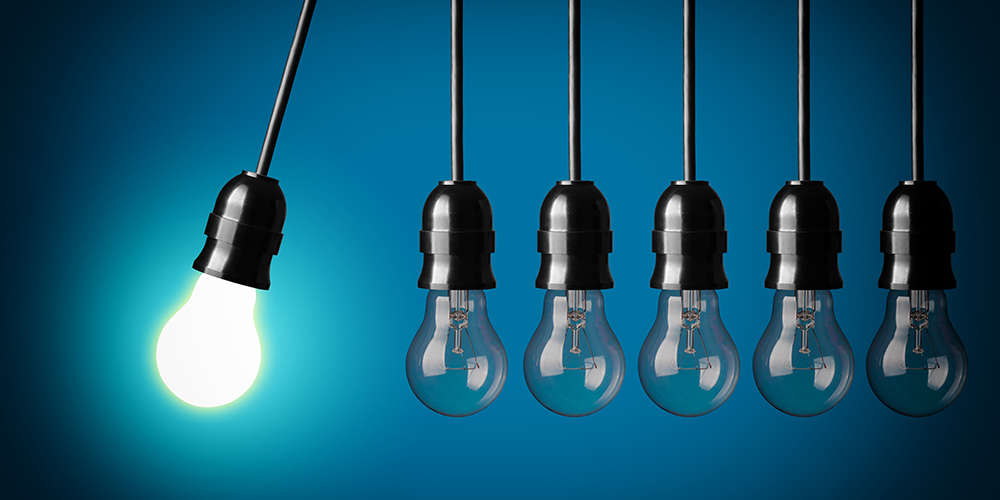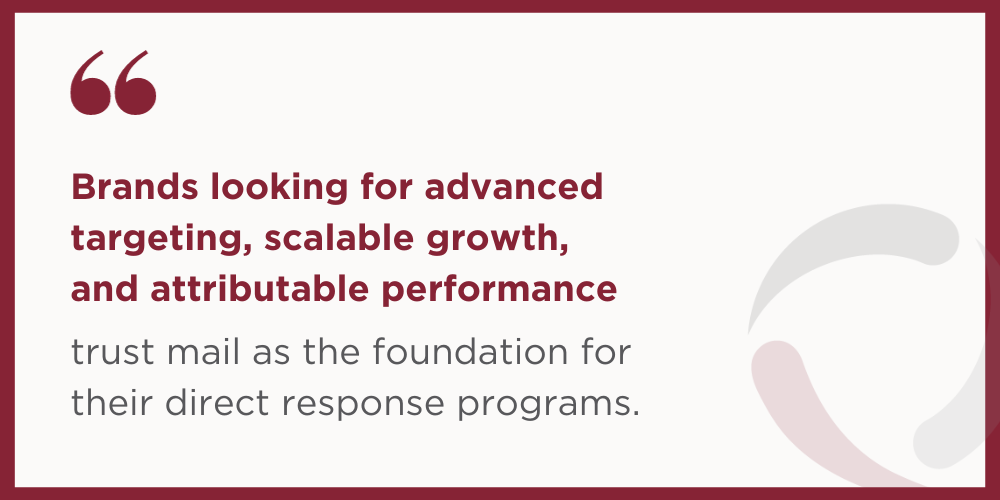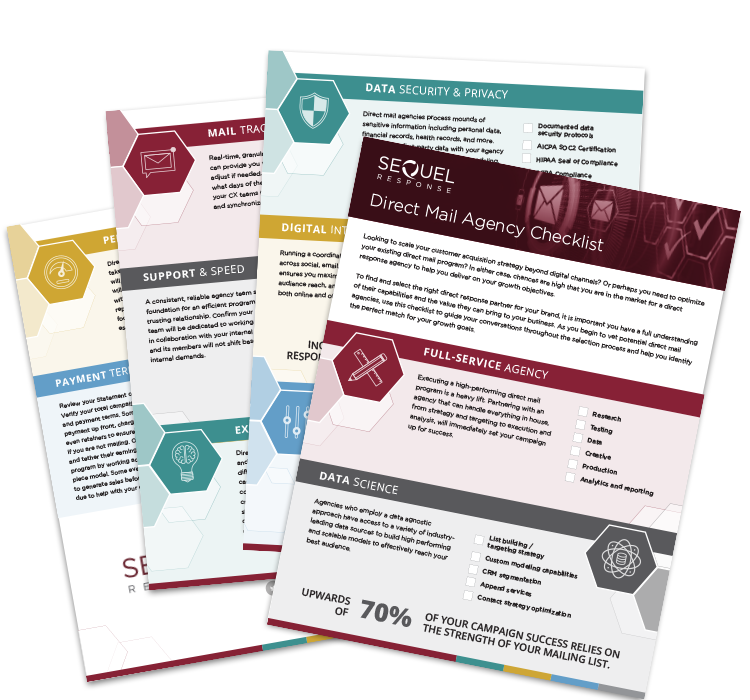Growing Your Brand Through Direct Response Marketing

Direct response marketing is a vital component in omnichannel strategies due to its ability to drive immediate conversions for lead generation, prospecting and sales, and customer loyalty marketing efforts. Here is a closer look at how you can use direct response marketing strategies to grow your brand, including major channels and key elements for success to get started.
Key Takeaways:
- Direct response is a type of marketing strategy used to provoke an immediate, specific action from the audience.
- This versatile marketing strategy can be used for lead generation, prospecting, cross-sell or upsell opportunities, winback, and retargeting for speedy target market conversions and long-term retention.
What is direct response marketing?
Direct response is a type of marketing strategy used to provoke an immediate, specific action from the audience. These campaigns are designed to generate trackable leads and sales quickly by driving customer conversions with an offer your audience simply cannot resist. Direct response ad tactics can be activated throughout the buyer journey to help nurture prospects from one stage to the next.
Although fundamentally different from traditional brand marketing, it is common for marketers to use direct response marketing and brand marketing strategies in tandem to build awareness, increase conversions, and propel brand growth.
What are the major direct response marketing channels?
Here are the most popular direct response marketing channels used by today’s marketers:
Direct Mail
Even in our digital world, direct mail response rates are six times higher than all digital channels combined, the channel produces a high ROI, and six out of ten marketers prefer direct mail over other offline channels. Neuro and behavioral science research have also confirmed direct mail is effective — proven to subconsciously appeal to human emotions and drive purchase intent. Brands looking for advanced targeting, scalable growth, and attributable performance trust mail as the foundation for their direct response programs.

Digital Marketing
Digital marketing can be used to describe all advertisements built for an electronic device or the internet, such as email, social media, video, search engine, display, etc. This channel is significant for growing DTC brands due to its flexibility and lookalike modeling and targeting capabilities. One of the key advantages of digital marketing is its seamless integration with direct mail, as 91% of marketers report that integration positively impacts campaign performance.
Radio
When you consider that 92% of U.S. adults listen to the radio each week, this media can be an effective and affordable direct response channel to reach a mass audience. In addition to demographic targeting options, brands often enlist local and national personalities to deliver customized messages to their market. Radio is a marketing tactic that can be used to share limited-time offers, host giveaways, and encourage listeners to take immediate action in real time.
Linear TV and CTV
As a legacy channel, linear TV is still recognized for its ability to reach large audiences and boost brand awareness. Although still young, the CTV (connected TV) and OTT (over-the-top) industry is booming, valued for its ability to reach a targeted and captive audience. According to our 2023 Direct Mail Marketing Benchmark Report, 42% of marketers consider linear TV a top channel for lead remarketing.
Influencer Marketing and Celebrity Endorsements
Both influencer marketing and celebrity endorsements act as a form of “social proof” for your brand and products. Whether it’s through social media or elsewhere, utilizing professional brand advocates as a marketing technique can be a great enhancement to your social strategy and help expand your audience reach. This channel has experienced explosive growth over the past few years and has evolved into a $21.1 billion industry.
Podcasting
Podcasts offer precise targeting, with a variety of genres and fewer content restrictions. This enables brands to reach specific and engaged audiences based on preferences, areas of interest, and demographics. Because podcast content is so specialized, podcast listeners tend to be highly engaged, trust host-read ads, and exhibit loyalty to both the podcast and the brands advertised. Consumers are therefore more likely to take action, and 82% of marketers expressed their intention to continue investing in direct response podcast advertising due to these advantages.
Identifying the right direct response channel for your brand depends on your budget, industry, offer, and target audience. It is common for marketers to leverage multiple channels to connect with potential customers across platforms via unified messaging and creative.
What are the key elements of a direct response campaign?
Successful direct response marketing campaigns include these critical elements:
Audience Targeting
To achieve the highest likelihood of conversion, direct response campaigns are targeted for the audience who is most likely to purchase your product or service. The attributes, preferences, and characteristics of your best customers are used to create customer profiles that drive audience selection. This ensures your advertisement and messaging are both relevant and personalized, and your budget is optimized.
In this e-book, we break down the process of audience modeling so you can optimize your customer data for profitable acquisition and campaign scalability.
Offer, Call to Action (CTA), and Deadline
We have nicknamed the offer, CTA, and deadline the direct response trinity. All three work together to create the sense of urgency that makes direct response advertising so effective.
Your offer tells the prospect what you are willing to give them for an immediate response. The more compelling your offer, the higher your response. We have found the best offers give the perception that you are giving something valuable away, such as an exclusive discount or a free gift. A clear CTA is arguably the most important direct mail design element, as it tells your audience exactly what they need to do to claim your offer. It needs to be noticeable, easy to understand, repeated, (and repeated again) throughout your medium. For instance, you might want potential customers to reach a specific landing page or join a referral program. Including an urgent deadline and including time limits for revealing an offer will play on a consumer’s natural fear of missing out, convincing them to act now.
Regardless of your overall campaign goal, you must optimize every element of your creative package and every word in your copy to provoke prospect response today, rather than tomorrow. Seasoned direct response copywriters keep the prospect focused and engaged by directly addressing their challenge/pain points, and using words such as you, your and you’re. They make your brand relatable and lower any perceived risks with customer testimonials and believable guarantees. Lastly, they use your unique selling proposition to clearly state why your products and services are the prospect’s best choice.
For more direct mail design insights, check out our e-book: Utilizing Direct Mail Creative to Alert & Convert: Secrets from the Pros.
Robust Testing Strategy
In the direct response industry, the clear route to success is marked with one word: test. Your testing strategy can be used to investigate any campaign variable such as which audience is most responsive, what offer generates the most conversions, and even which channels perform best together. The key to accurate testing is isolating the challenging variable against your control. A regular and robust testing strategy includes a mix of small and large elements. Not only will this keep your campaign fresh, but it will also allow you to maximize your profitability while managing performance risk.
New to testing? Don’t make these 9 testing mistakes.
Brand Loyalty
One of the major benefits of direct response marketing is the ability to establish strong, long-lasting relationships. You can effectively connect with your audience by utilizing personalized follow-up messages and retargeting ads to keep them informed about new products or services and encourage them to take action. This not only helps to increase brand loyalty, but also creates a sense of trust and credibility, which ultimately leads to higher conversion rates and increased revenue for your brand.
Direct mail retargeting mistakes can be costly. Discover 5 retargeting mistakes and how to avoid them.
Data-Driven Success
Direct response is a marketing strategy that is highly measurable and provides valuable insights through a variety of informative metrics. To gauge the effectiveness of a direct response campaign, you can track campaign activity with a directly attributable element, such as offer code redemptions, landing page activity, telephone calls, QR codes, and more. A matchback and holdout strategy will also help to determine channel impact as only about a third of responses will come through a directly attributable item.
By analyzing metrics like conversion rates, click-through rates, and cost per acquisition, you can easily measure and optimize your campaigns for better results. This data-driven approach allows you to make informed decisions and continually improve your campaigns, leading to more efficient achievement of your marketing goals.
Download the Ultimate Guide to Direct Mail Attribution to learn more about tracking and reading direct mail campaign performance.
Integrated Strategy
USPS research found that using direct mail and digital marketing channels together increased website visits by 68%, increased response rates by 63%, and resulted in a 40% conversion rate. By surrounding your best audience with cohesive messaging across the channels they naturally interact with each day, you’re increasing your odds of conversion and reducing your customer acquisition costs.
Download this e-book to learn more about integrating your direct mail and digital marketing strategy.
Is direct response marketing right for my brand?
Whether your brand is B2B or DTC, national or local, brick and mortar or e-commerce, direct response marketing can be beneficial for sales growth and audience reach. The versatile form of marketing can be used for lead generation, prospecting, cross-sell or upsell opportunities, winback, and retargeting for speedy conversions and long-term retention. Most direct response channels show a return on investment quickly after the campaign is launched, as targeting data and directly attributable elements (such as campaign-specific URLs, toll-free phone numbers, promo codes, etc.) allow marketers to track the channels that impacted the final sale. Partnering with a reputable direct response agency will help you quickly, and cost-effectively, test channels and strategies to identify the winning combination to meet your program objectives.
If you’re not sure where to start, try our free Direct Mail Impact and LTV Calculator to determine if direct mail is right for your brand, right now.

